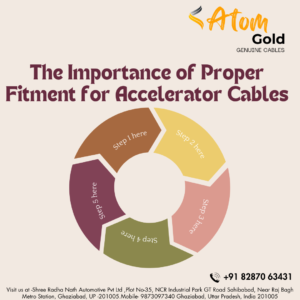The accelerator cable, also known as the throttle cable, is a crucial component in a vehicle’s throttle system, transmitting the driver’s input from the accelerator pedal to the throttle body. Proper fitment of the accelerator cable is essential for ensuring optimal vehicle performance, safety, and longevity. This article delves into the significance of proper fitment for accelerator cables, the potential consequences of improper fitment, and best practices for ensuring correct installation.

1. Understanding the Accelerator Cable’s Role
The accelerator cable is a mechanical link that controls the engine’s throttle based on the driver’s input. When the accelerator pedal is pressed, the cable pulls on the throttle linkage, opening the throttle body and allowing more air into the engine. This process increases the engine’s power and, consequently, the vehicle’s speed. A properly fitted accelerator cable ensures smooth, responsive, and reliable throttle operation.
2. Importance of Proper Fitment
a. Optimal Performance
- Smooth Throttle Response: A correctly fitted accelerator cable allows for smooth and precise throttle response. The cable should have the right amount of tension, without being too loose or too tight. This ensures that the throttle body opens and closes accurately according to the pedal input, providing consistent acceleration and deceleration.
- Engine Efficiency: Proper fitment ensures that the engine receives the appropriate amount of air and fuel mixture, which is vital for optimal combustion and engine efficiency. This results in better fuel economy and overall engine performance.
b. Safety
- Consistent Control: Properly fitted accelerator cables provide consistent control over the vehicle’s acceleration. This is crucial for maintaining control in various driving conditions, such as merging onto highways, overtaking, or navigating through traffic.
- Prevents Sticking: An incorrectly fitted cable can lead to throttle sticking, where the throttle body fails to return to its idle position when the pedal is released. This can cause unintended acceleration, posing a significant safety hazard.
c. Longevity and Durability
- Reduced Wear and Tear: Proper fitment minimizes undue stress on the accelerator cable and its components. This reduces wear and tear, extending the lifespan of the cable and associated parts.
- Prevents Damage: Incorrect fitment can lead to cable fraying, stretching, or breaking. It can also cause damage to the throttle body, accelerator pedal, and other components of the throttle system.
3. Consequences of Improper Fitment
a. Poor Throttle Response
- Lag or Hesitation: An improperly fitted cable can cause lag or hesitation in throttle response. This can make the vehicle feel sluggish and unresponsive, negatively impacting driving experience.
- Inconsistent Acceleration: Improper fitment can lead to inconsistent acceleration, making it difficult to maintain a steady speed. This can be particularly problematic in situations that require precise throttle control.
b. Increased Maintenance Costs
- Frequent Repairs: Improper fitment can lead to frequent breakdowns and the need for repairs. This can result in increased maintenance costs and vehicle downtime.
- Component Damage: Misalignment or incorrect tension can cause premature wear on the accelerator cable and damage to other components, necessitating costly replacements.
c. Safety Risks
- Throttle Sticking: Improper fitment can cause the throttle to stick, leading to unintended acceleration. This is a significant safety risk, as it can result in loss of control and potential accidents.
- Sudden Failures: An improperly fitted cable is more likely to fail suddenly, leading to unexpected loss of throttle control. This can be dangerous, especially at high speeds or in heavy traffic.
4. Ensuring Proper Fitment
a. Correct Sizing and Specifications
- Manufacturer Specifications: Always use an accelerator cable that meets the manufacturer’s specifications for your vehicle. This ensures that the cable is the correct length, diameter, and material for optimal performance.
- Quality Components: Invest in high-quality cables from reputable manufacturers. Quality components are more likely to fit correctly and perform reliably.
b. Professional Installation
- Experienced Technicians: Have the accelerator cable installed by experienced technicians who understand the intricacies of the throttle system. Professional installation ensures that the cable is fitted correctly and adjusted to the proper tension.
- Proper Tools and Techniques: Ensure that the correct tools and techniques are used during installation. This helps avoid damage to the cable and associated components.
c. Regular Maintenance and Inspection
- Routine Checks: Regularly inspect the accelerator cable for signs of wear, damage, or improper fitment. Early detection of issues can prevent more serious problems down the line.
- Lubrication: Keep the cable properly lubricated to ensure smooth operation and reduce wear. Use the lubricant recommended by the manufacturer.
d. Proper Adjustments
- Tension Adjustment: Ensure the cable tension is correctly adjusted according to the manufacturer’s guidelines. Proper tension allows for smooth and responsive throttle operation.
- Cable Routing: Proper routing of the cable is crucial to prevent kinks, bends, or friction. Ensure the cable is routed correctly and securely fastened to avoid interference with other components.
5. Conclusion
The proper fitment of accelerator cables is essential for maintaining optimal vehicle performance, safety, and longevity. A correctly fitted cable ensures smooth throttle response, consistent control, and efficient engine operation. It also reduces the risk of throttle sticking, premature wear, and costly repairs.
Vehicle owners and technicians should prioritize using the correct cables, professional installation, regular maintenance, and proper adjustments to ensure the accelerator cable functions as intended. By paying attention to these details, you can enhance your vehicle’s performance, ensure a safe driving experience, and extend the life of your throttle system components.
Investing time and effort into ensuring the proper fitment of accelerator cables is a small but significant step towards maintaining a reliable and high-performing vehicle. Whether you are a vehicle owner or a professional mechanic, understanding the importance of proper fitment and implementing best practices can make a substantial difference in the overall health and performance of the vehicle’s throttle system.
